Rules for refilling household gas cylinders at gas filling stations: norms and safety requirements
A gas cylinder on a summer cottage or in a country house is a common occurrence, but extremely troublesome.After all, the supply of blue fuel in them will have to be periodically restored, observing the rules for refueling household gas cylinders at gas filling stations. And the cylinders themselves must meet special conditions.
You will learn all about the standards and requirements for filling tanks with liquefied gas from the article we presented. We will tell you which cylinders are suitable for refilling and further operation, where and how best to produce it. We will warn you about the problems that most often accompany this event.
The content of the article:
- What does the legislation say?
- The danger of filling cylinders at gas stations without a license
- Types and features of gas storage cylinders
- Inspection of cylinders. How to find out service life
- Why shouldn’t you fill up at regular gas stations?
- Gas filling station services
- Rules for refilling cylinders
- What is better: exchange or refill?
- Replacement procedure, safety during transportation
- Several important nuances for operation
- Conclusions and useful video on the topic
What does the legislation say?
Gas stations, gas distribution stations and other gas supply facilities belong to the most complex operational category. The legislation provides for strict safety rules, in accordance with which all actions are carried out at the facilities and surrounding areas.
The storage and operation of a gas cylinder in the domestic sphere is explained by Decree of the Government of the Russian Federation dated December 26, 2016 No. 1498. It regulates the provision of public services and the operation of common property.One of the paragraphs describes the issues of purchasing, refilling and exchanging household gas cylinders.
Important highlights that matter to everyone types of gas cylinders:
- the cylinder must be in good working order;
- have unexpired best before date;
- sales are carried out only in special licensed points;
- Refueling is carried out at “gas filling stations”.
It follows that at regular automobile gas stations, refueling is prohibited by the rules for the design and use of equipment operating under pressure. And this is not a whim of legislation, but a real act of caring for citizens.

The danger of filling cylinders at gas stations without a license
The fact is that household and automobile cylinders differ in design: the latter have special cut-off valves that prevent the tank from overfilling.
The gas supply system turns off automatically when the norm is reached (not higher than 85%). But in cylinders intended for domestic use, such cut-offs are not provided. Another nuance - car systems are filled in liters, and household ones - in kilograms.
In licensed “gas filling stations” this issue is resolved simply - the cylinder is filled on a scale. Everything is done taking into account the amount of residue and newly supplied gas. The tank itself must be checked for leaks, service life, and the presence of heavy fraction residues.
Since 2017, regular gas stations for cars have stopped refilling household gas cylinders. On the one hand, it is clear that after several emergency situations with explosions, government agencies paid attention to this problem.However, on the other hand, they have not yet been able to solve it completely due to a lack of licensing points.
And if, when contacting a car gas station When your tank is filled, you should know that both you and the gas station are breaking the law.
Let's consider what legal options we have for filling a gas cylinder, what are the basic rules according to which household gas cylinders are refilled at gas station, as well as other important information on the operation of gas equipment with removable media.
Types and features of gas storage cylinders
Manufacturers produce several types of steel cylinders of different volumes: 5, 15, 25 and 50 liters. Weight - from 4 to 22 kg. For example, a 50 liter cylinder weighs 44 kg. Recently, cylinders made of polymer composite materials in volumes of 14 or 33 liters have been developed and produced.
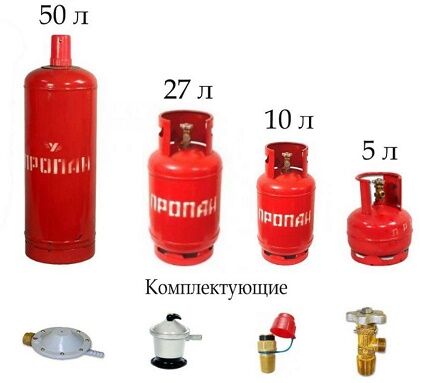
Types of tanks for household use
Based on the material from which the body is made, cylinders for household use are divided into the following groups:
- Steel cylinders - strong and durable. Their vulnerable point is the welding seams, therefore, when purchasing and inspecting, great attention is paid to the inspection of welding seams. It is recommended to choose the right place to install the equipment, excluding places of high humidity, so as not to corrode steel models.
- Composite containers. This is a more modern option. Composite gas cylinder It is also quite durable and costs 2-3 times more due to the high cost of materials containing fiberglass.Additional body protection enhances strength.
Polymer cylinders are easier to transport because they weigh less and are less subject to deformation when impacted or dropped. Another advantage of polymer equipment is high heat resistance. It may be near a fire.
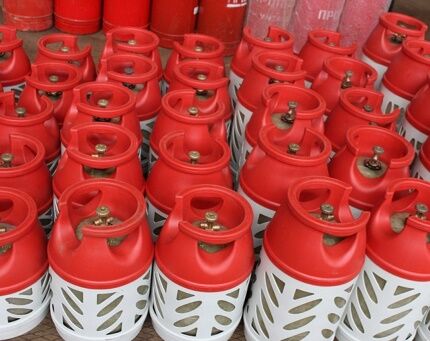
How do color and purpose relate?
According to GOST rules, the color of the cylinder determines its purpose:
- white ones with yellow inscriptions are filled with acetylene;
- red - for propane;
- blue – for medical or regular oxygen;
- dark green ones store hydrogen;
- in gray with black elements - nitrous oxide.
For use in our domestic conditions and regular replenishment of liquefied fuel, only red tanks with appropriate markings are suitable.
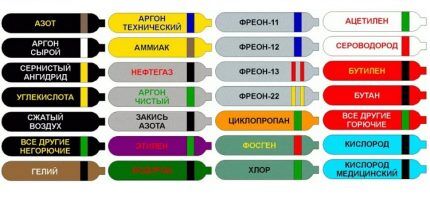
Inspection of cylinders. How to find out service life
Household propane cylinders are metal sealed containers of a certain volume for storing gas. The material of manufacture is a steel alloy with additions of chromium and molybdenum. From the manufacturer they go into free circulation. They are used in specialized companies as equipment, in enterprises, and in households.
Each cylinder is accompanied by a paper passport from the manufacturer. The data is duplicated in the form of metal inscriptions on the back of the case, next to the company’s brand.
The technical condition of cylinders must be strictly controlled in accordance with GOST 15860.To determine the possibility of further operation, an inspection procedure is carried out.
Subject to inspection once every five years:
- products manufactured before February 2014 can last up to 40 years;
- products manufactured after February 1, 2014 – up to 20 years.
The “metal passport” indicates the date of manufacture of the product, volume, weight, and date of last inspection. According to the rules of use, cylinders without metal passports or with unclear inscriptions cannot be refilled and cannot be exchanged.

And it is right. The “life” of each cylinder proceeds differently: some products are in constant use, others can gather dust in the garage for years in order to be used for specific purposes at the right time.
Do not forget that faulty equipment for storing hazardous substances (gas) can cause disaster.
Why you shouldn’t refuel on regular ones gas station?
The question of whether it is possible to refill household gas cylinders at a gas filling station is worth considering in more detail. According to the law, liquefied gas can only be sold in specially equipped points. But many gas stations are trying to make money by circumventing the law.
When purchasing gas at such a gas station, consumers should remember not only legal liability, but also the danger that an incorrectly filled cylinder poses.
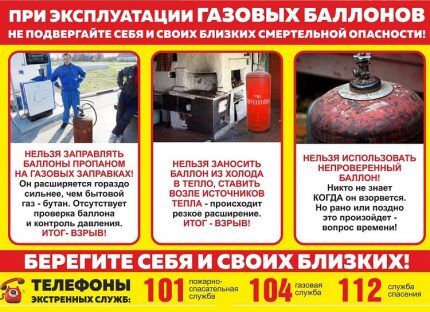
And the risks are great if:
- the container is not checked for leaks;
- inspection control, and therefore serviceability, is not carried out;
- but the most important thing is that at car gas stations there is no way to check the filling capacity required by the approved standards (85% of the volume).
The free zone creates a “vapor cap” that prevents gas expansion. For example, when heated under the sun. How much liquid substance is needed can be easily calculated by dividing the nominal volume by 1.43. For example, for a cylinder designed for 22 liters, it is enough to add 15.38 liters of liquefied gas.
If there is no cut-off valve, the work is carried out literally “by eye”, so there is a high possibility of overfilling the container, which means increasing the possibility of a catastrophic risk.
Therefore, before refilling an empty gas cylinder, gas station, make sure that the point has special equipment for this, including weighing scales. But it is better to fill containers at special gas filling stations to ensure weight control.
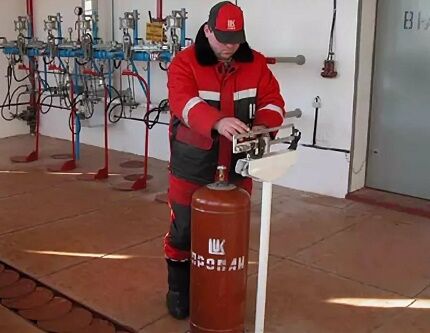
Gas filling station services
These are companies that fill gas into any permitted containers. The gas filling station must be equipped with special equipment that determines the gas filling method.
There are three ways to fill with gas:
- pumping;
- pump-compression;
- pump-evaporation.
The name of the equipment speaks for itself.These are pumps, compressors to create increased pressure, an evaporator, a heater to provide increased pressure. The following must also be present: hoods, gas storage tanks, technical equipment (density meters, dispensers).
A mobile modular station is a version of a small gas distribution station for refilling oxygen cylinders, most often used for medical institutions or construction enterprises that use oxygen when carrying out welding work.
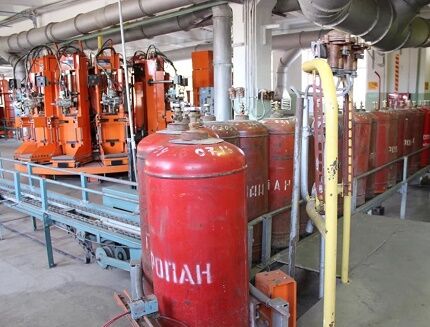
Large stations use cylinder filling stations with electronic weighing units, including an industrial controller and a gas supply valve. When installing the cylinder on the cargo receiving platform of the scale, the amount of residues and the weight of the new arrival are automatically recorded.
When the required volume, set in advance on the electronic unit, is reached, the gas supply automatically stops.
Rules for refilling cylinders
There are safety requirements for refilling a standard cylinder. Mandatory marking “compressed gas” and a special sticker indicate an explosion hazard.
The equipment must be checked according to the following parameters:
- serviceability;
- presence of residual pressure;
- valve or valve defects;
- presence of rust on the surface, peeling of material;
- dents or damage.
Before refueling, condensate and remaining gas are removed from the cylinder and it is checked for serviceability.
At specialized stations, equipment is used - a gas supply hose with valves, an adapter - adapter.
What is better: exchange or refill?
Get a cylinder of gas needed for work gas boiler, stoves, outdoor lighting lines, etc., there are two ways: refill your container or exchange it for another one that has already been refilled.
In the first case, the cylinders are left at the station for 1-2 days, the consumer receives his full container.
In the second - a quick exchange of an empty container for a filled one. Consumers can make their own choice about which method to use. The second method is faster, but you get someone else's equipment, which may not be the newest. The cost depends on the type and volume of gases. Standard case: 200-300 rubles.
What problems can occur when refueling?
Nuances that are important to know about filling gas cylinders:
- Some Chinese cylinders have thin walls. They are not designed for heavy loads. It must be remembered that cheap equipment may not pay off due to high risk.
- Active gases are prone to fire and explosions, so you need to especially carefully monitor the volume (85%) when filling with propane, oxygen, methane.
- To use household gas at low temperatures, it is better to use winter propane-butane mixtures, with the advantage of propane, since butane is of little use for winter use.
In order to prevent the occurrence of the listed problems and risks associated with replenishing the supply of liquefied explosive substances, it is necessary to think through the process in advance and provide for all the nuances.
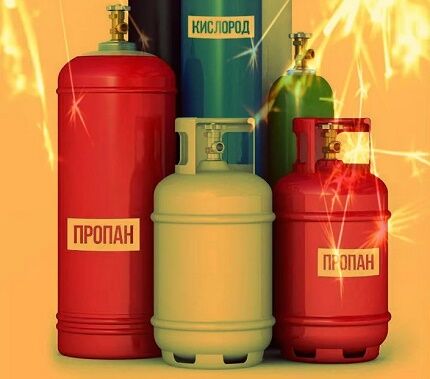
Replacement of the cylinder with a new one, repair
Sooner or later the cylinder wears out, the valve may fail, and the surface will begin to delaminate. Almost every city has a cylinder replacement or repair point. You can give away the old one and get a new product, with an additional payment of approximately 1,500 rubles. This is a good alternative to buying new equipment.
If the valve is subject to repair, it is repaired or completely change. The cylinder itself can be sanded and painted. The cost of a new empty propane cylinder: from 2,500 to 600 rubles, depending on the manufacturer’s materials.
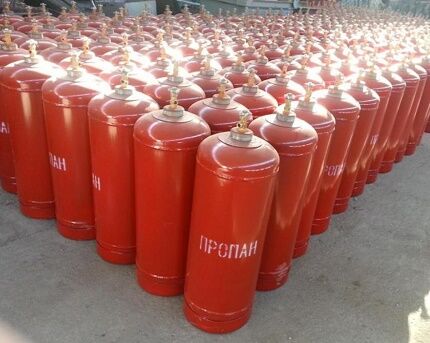
Replacement procedure, safety during transportation
The design of the cylinders differs in the presence of a closing valve KB-2 or a technical valve VB-2 in accordance with GOST 21804–94. In versions with a valve, there is a quick-release reducer that reduces the pressure when a flame appears.
The reducer is attached to the main hose through a fitting with a small mounting clamp:
- The reducer is attached to the cylinder with the valve by pulling it onto the neck of the valve with an o-ring.
- It is connected to the valve by means of a thread on the valve fitting, in another case - by a union nut of the gearbox. At replacement points, a special disposable gasket is provided.
If the gas pressure has noticeably decreased and is going to zero, you should not squeeze it to the last drop:
- Turn off the gas, close the valve and begin replacing the cylinder.
- Remember that the gearbox has a left-hand thread. Unscrew the gearbox nut clockwise.
- Replace the cylinder.
- Prepare paronite replacement gasket. The nut must be tightened counterclockwise.The cylinder must stand strictly vertically (never turn it over).
- Be sure to close the tap of the old cylinder, install a plug and a protective cap. This is important because some amount of gas always remains in the cylinder.
Always close the valve when the stove is not working.
Transportation of cylinders is carried out only with safety caps and plugs. When transporting, make sure that the valve is closed and protected by a cap.
Several important nuances for operation
Simple rules will help you use cylinders conveniently and safely in dachas and country houses:
- Do not smoke when changing the cylinder. It is forbidden to keep an open flame nearby and check for leaks using fire (a lighter or matches).
- Keep the valve fully open and fully closed when appliances are turned off.
- Do not operate power tools in close proximity to the cylinder to avoid sparks. conductive the rotor brushes did not burst into flames due to an unnoticed gas leak.
Compliance with the requirements for competent and careful operation of liquefied gas tanks is a norm that guarantees the safety of the user and others, as well as the safety of property.
He will familiarize you with the nuances and rules for filling gas cartridges required for the operation of burners. next article. We recommend reading this very useful information.
Conclusions and useful video on the topic
Refueling fifty liter balloon. Specialized gas stations have the necessary equipment. Cylinders must be checked for integrity and the valve inspected. Refilling time is approximately 5-10 minutes. Safety precautions are observed:
Operate gas equipment carefully.Try to protect the housing from impacts to prevent gas leakage:
After replacing the cylinder, inspect and evaluate the tightness of the connections, make sure there are no gas leaks. You can coat the connections with foam from the soap solution and observe:
A gas stove is the best option for domestic use when there is no centralized gas pipeline. Knowing how to properly refill a gas cylinder gas station With the necessary equipment, following safety precautions during transportation and operation, you can make life comfortable and convenient.
Could you share your experience gained from filling a household cylinder with the most affordable type of fuel? Do you have useful information on the topic of the article that is worth sharing with site visitors? Please leave comments in the block below, ask questions, post photos.




Hello. I arrived at a gas station to fill a propane tank, and they asked me for a “subscription book.” Although, when selling the cylinder, I was told that nothing was needed for subsequent refills. This is fine?!
This is normal when installing the stove permanently in a house, country house, or enterprise.
But this cannot and is not possible to extend to portable stoves. Actually, this is a complete mess right now, they fill gas stations at random.
That’s why there are “cylinder explosions,” although the cylinder itself cannot explode—there is no oxygen in it. They burst and then the gas-air mixture pops from the next. sparks.
Hello. We fly in hot air balloons (hot air balloons), we fly on a propane-butane mixture.The set includes 4 cylinders (we personally have 50 liters each) Our cylinders are equipped with a safety cut-off device for filling 85% of the full capacity of the cylinder, but it is manual, i.e. there is a valve from which the gas phase comes out when filling as soon as it starts to escape liquid phase of gas, the cylinder is manually closed. Our cylinders are not household, but not automobile. At all gas stations we are faced with misunderstanding, everyone says that they do not refill cylinders, citing the fact that it is impossible to control refilling, they equate our cylinders with household ones. Nobody wants to understand it more specifically; it’s easier to ban it. There are passports for the cylinders, there is an instruction manual, which states that filling should not exceed 85%, etc. Your text mentions the difference that cars are refueled at 85%, but ours are somewhere between household and car. This problem is acute throughout Russia for all balloonists. We are looking for any opportunities to legalize. Maybe you can suggest something? We would be very grateful. Links to regulations, etc.
Tell me, what if I need 27 liters for gas stations? The gas cylinder was filled with 25 liters. How to protect yourself now.
I bought a new gas cylinder, do I need to do additional work to fill it before the first refueling?
A 27 liter cylinder is filled with only 9 kg of gas, why so instead of 10 kg
Is it possible at the gas station to replace the existing grk with a grk with scales and refill vehicles and household cylinders? These are available. Thank you